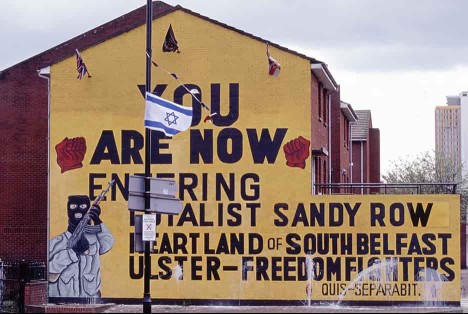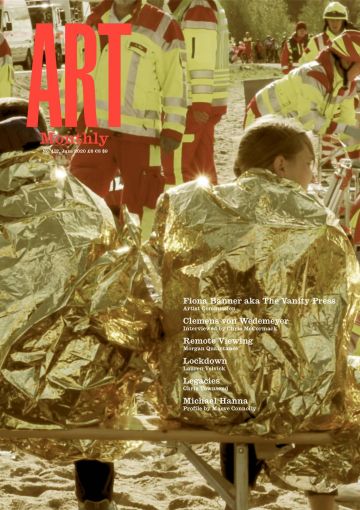Profile
Michael Hanna
Maeve Connolly examines the artist‘s interest in time travel, everyday language, patterns and technological utopianism

Michael Hanna, Short Films About Learning, 2015
In late November 2019, when what is now taken for granted lay beyond imagination, Michael Hanna’s solo exhibition opened at PS2 gallery, the project space run by Belfast’s Paragon Studios. Using the time-travel conceit of Edward Bellamy’s 1888 utopian novel Looking Backward as a framing device, Hanna reconfigured the typical forward-orientation of the project show to stage a dialogue between the past and present of his practice, mining personal and social archives to undercut prevailing fictions of progress. In those days, the gallery was based in a former retail unit located at the slightly dilapidated end of a busy shopping street. A large yellow neon sign, using the default Microsoft Office font Calibri, was installed across the full width of the former shop display window. It announced the presence of Compuders!, 2019, giving physical form to the distinctive Northern Irish pronunciation of a once-new word.
Compuders! is not the only work by Hanna to explore the very specific force of the written word in public space. His earlier single-channel video installation Short Films About Learning, 2015, features images of Belfast streets, documenting struggles over territory, history and memory. Commissioned as a response to the Belfast Exposed photography archive, the video consists of precisely ordered selections of still images documenting decades of conflict, synchronised to excerpts from audio recordings of lectures by Yale psychology professor Paul Bloom. It is structured into four separately titled sections, on ‘the spotlight effect’, ‘habituation’, ‘object permanence’ and ‘subliminal priming’. But these are not the only words to appear on screen, as many of the photographs feature written warnings or proclamations: a man and woman stand beside the words ‘get out’, painted in large letters on their shop window; a teenager covered in paint wears a handwritten sign around his neck bearing the claim, ‘I terrorise pensioners and sell glue to underage children’. Each of the four sections features different photographs, but they depict a similar range of situations and events – political murals, barricaded streets, public punishments, elaborate funerals, protest marches.
Bloom uses everyday language to explain common psychological processes, such as habituation: ‘harmful stimuli are noticed but when something has shown itself to be part of the environment, you don’t notice it anymore’. The pace of the image edit is dictated by the speed and rhythm of his US-accented voice and there are brief moments of stasis as he pauses to catch a breath, gather his thoughts (‘ummm’) and interact with his students. He is easy to follow, but Hanna’s film introduces the possibility of a communication embedded in the form rather than content of his speech, emitted as a pattern or a code. Yet Hanna is perhaps more interested in the cultural imagination of patterns than in the actuality of their existence. His single-channel video Indoor Sunlight, 2019, installed in the dark interior of PS2, owes its title to one of the many ‘patterns’ described in A Pattern Language: Towns, Buildings, Construction, an influential manual on architecture and urban design authored by researchers at Berkeley’s Center for Environmental Structure in 1977. Addressed to both professionals and communities, the book engages with the social and physical world as a series of interconnected patterns, using this term to describe not only specific problems but also their solutions. The section on ‘indoor sunlight’ explains how domestic spaces should be arranged around the sun’s daily movements, outlining a precise and productive interaction between temporal and spatial rhythms. Hanna’s Indoor Sunlight video includes fragments of recordings made on journeys to utopian settlements, but it consists primarily of materials gathered online over a period of years, culled from industrial film, corporate branding communications, cinema, television and urban design visualisations. Several clips involve direct encounters with unfamiliar technologies, which are vaguely sinister or overtly comical. So, for example, ‘HAL’ describes his capabilities to an interviewer in a scene from 2001: A Space Odyssey and, several decades after the making of Stanley Kubrick’s film, Victor Meldrew of One Foot in the Grave confuses a small pet with a large cordless phone. Artists, designers and planners seem to figure in Hanna’s video primarily as mediators of technological change, charged with the task of path-finding. In one sequence, Andy Warhol shows how the latest version of Amiga computer software can be used to create a portrait of Debbie Harry, taking his task as demonstrator seriously, despite the laughter of the studio audience. Warhol’s verbal reticence contrasts sharply with the upbeat voice-overs that accompany visualisations of transport plans for Belfast, including a physical model of the Westlink motorway and a computer-generated animation of an integrated road and rail system that promised a clear route to peace and prosperity, but which was never fully realised.
At PS2, Hanna’s exhibition extended beyond the gallery to a hallway cluttered with safety signage, used to display The Ones Who Walk Away, 2019, two matched photographs of aeroplanes flying low over schools. The older, slightly fuzzier image was found online and it provided the prompt for the second sharper one, shot by Hanna near a school in east Belfast. This work directly references Marc Augé’s theorisation of non-places that can be passed through yet resist permanent settlement, including airports and outer space. The photographs also evidence the altered significance of the flight path in the era of climate crisis. Images that once signalled futurity, or the wistful desire to escape, now communicate a straightforward tension between the lives (and rights) of those in the air and those on the ground. The Ones Who Walk Away can be interpreted, somewhat literally, as an allusion to Hanna’s own choices as an artist, particularly when considered in relation to the oldest work at PS2, a painting from 2007 titled The Diagnostic View IV. Featuring an extreme close-up of a man’s face wearing an expression of faint uncertainty, this work is identified as a copy of Luc Tuymans’ 1992 painting Der Diagnostische Blick IV, itself based on a photograph from a medical text explaining the principle of clinical objectivity. Hanna made his copy as part of an application to a German anthroposophical art school, so it is a material relic of a possible educational trajectory, apparently never pursued.
In the exhibition text that accompanied ‘Looking Backward’, Hanna’s painting is presented as an introduction to ‘the practitioner as author and active utopia creator, capable of linking the present with the future and existing simultaneously in different states’. Just as the medical practitioner is expected to scan the human body for evidence of past behaviour, discern what is currently unfolding and predict what is yet to come, the artist is expected to demonstrate insight regarding past, present and future, and be rewarded for materialising this insight through the unfolding of their own practice. Hanna exploits the institutionally conventionalised narratives of both practice and project, perhaps most explicitly in the darkly funny Calculated Error, 2012, which involved securing an arts grant to fix a series of mistakes that were yet to be made, such as getting a misspelled tattoo to be ‘corrected’ by laser removal. Calculated Error was not repurposed within ‘Looking Backward’, perhaps because it is so self-contained that it forms a perfect closed loop. Unexpectedly, Hanna’s show was extended beyond its original December 2019 closing date because Paragon Studios and PS2 were required to move elsewhere. Wholly disconnected from the disaster of Covid-19 that caused every gallery in the city to be shuttered, this was just an ordinary crisis for an artist-run organisation. A new building (inaccessible at the moment) was quickly found, and the everyday labour of utopia-creation continues.
Maeve Connolly is co-director of the ARC Masters programme at Dun Laoghaire Institute of Art, Design and Technology, Dublin.
First published in Art Monthly 437: June 2020.











